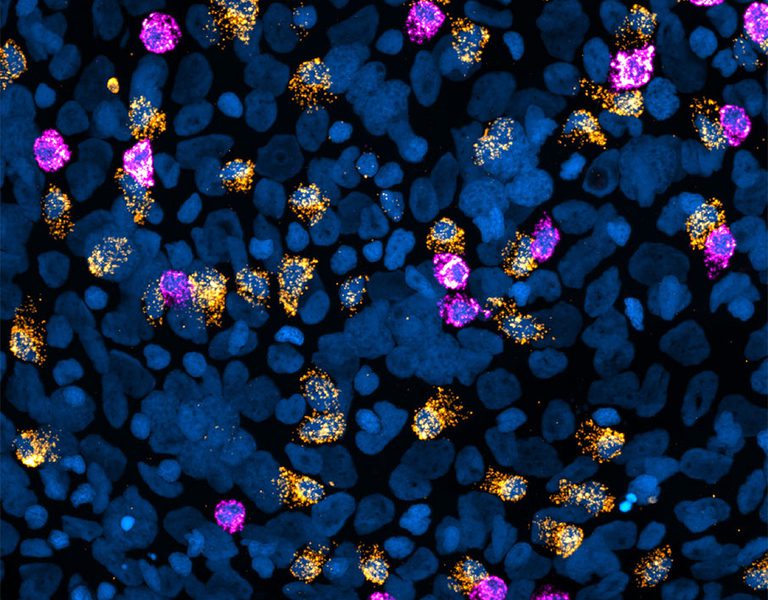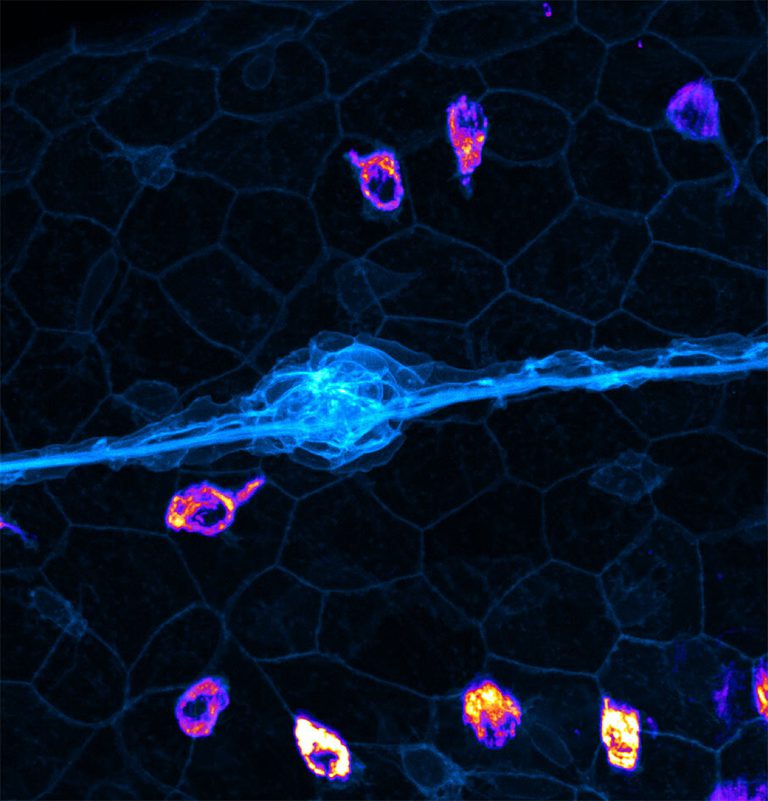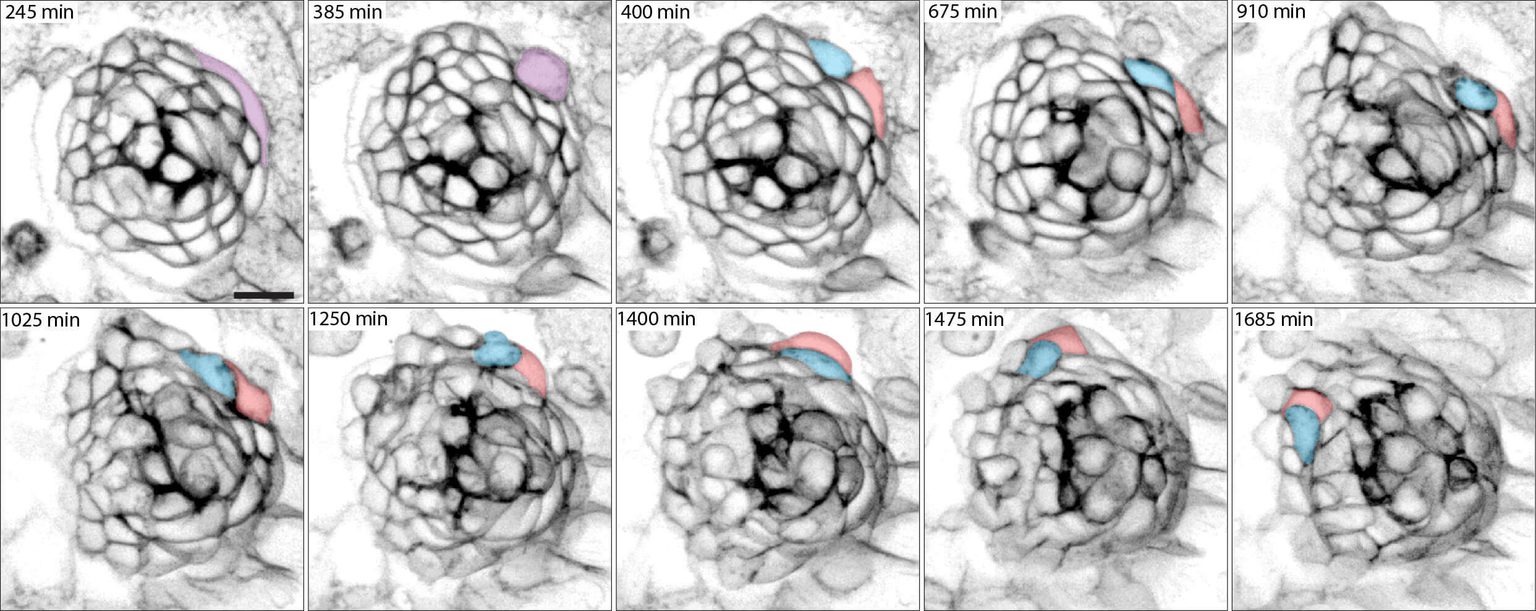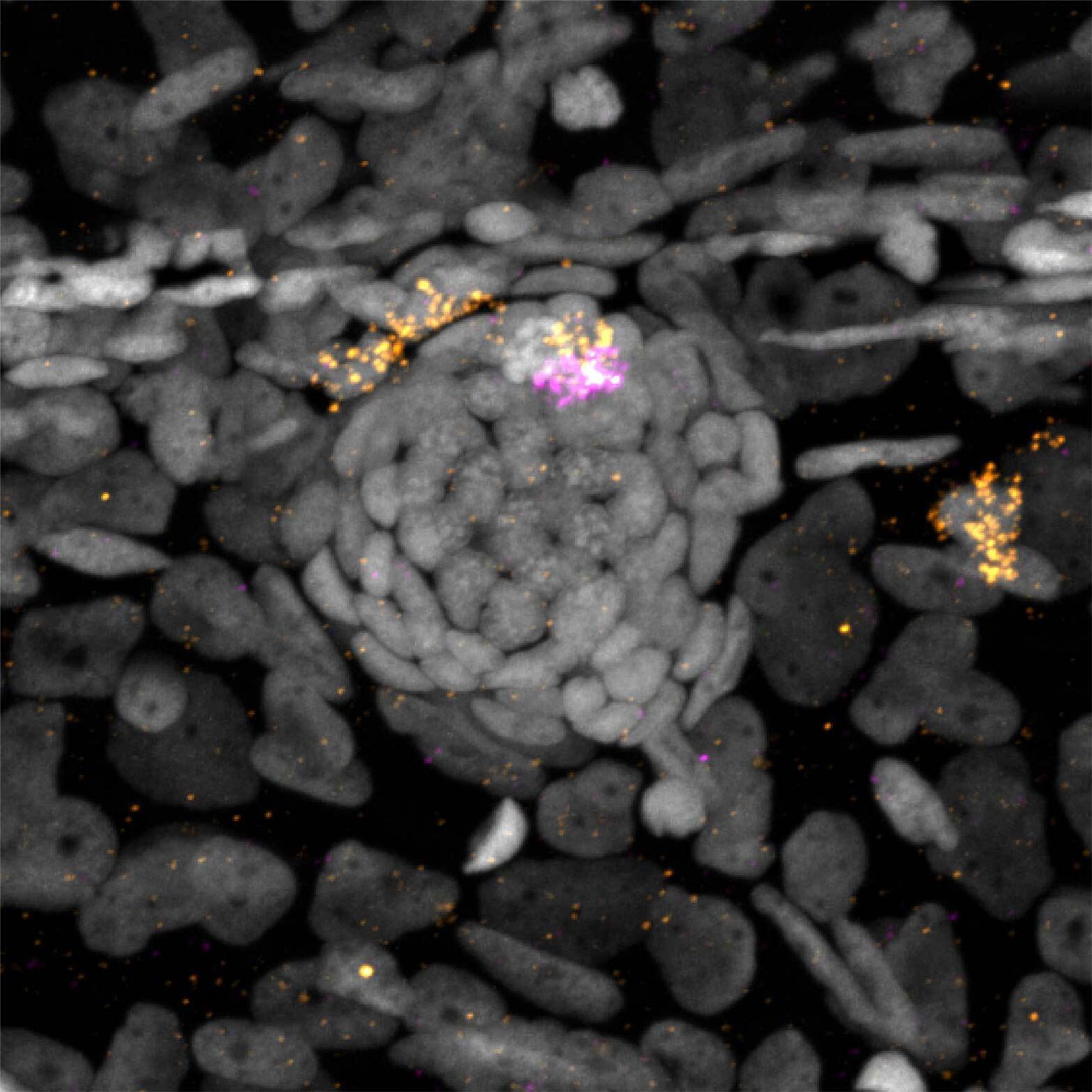News
15 April 2025
Light sheet microscopy: A decade-long journey from DIY innovation to cutting-edge imaging
A look at the technology that provides researchers with deeper insights into complex biological systems.
Read Article
News
The findings show how some animals adapt to dramatic seasonal fluctuations, potentially providing clues for how they may cope with a changing climate

Confocal microscopy image shows cell nuclei in zebrafish skin (blue) and different types of skin ionocytes (magenta, orange).
By Rachel Scanza, Ph.D.
Some species can perform remarkable biological endeavors in response to environmental factors. For example, temperature can control the sex of turtles and season can cause Arctic foxes’ fur to change colors. New research from the Stowers Institute for Medical Research has uncovered an additional process cued by environmental changes that drives zebrafish sensory organ development, a mechanism with the potential to provide resilience to climate change.
Zebrafish skin is dotted with neuromasts, small sensory units, that help the fish detect water motion, prey, and predators. Within each neuromast are hair cells, both structurally and functionally resembling hair cells of the human inner ear that allow us to detect sound. A previous study from the lab of Investigator Tatjana Piotrowski, Ph.D., identified a new type of ion-sensing cells specific to neuromasts, called neuromast ionocytes, which invade these organs upon a sudden drop in the salt concentration of water. Now, the Piotrowski Lab is investigating precisely how environmental factors cause neuromast ionocytes to develop into functional sensory organ helper cells.
“Historically, biological research has primarily focused on how genes impact organ development,” said Piotrowski. “This recently discovered cell type seems to be governed by environment rather than genetics.”

Confocal microscopy image showing skin ionocytes in red/orange and a neuromast in cyan.
“Here, we are tackling an emerging question in developmental biology: How do external factors drive organ development?” said Julia Peloggia, Ph.D., a former predoctoral researcher in the Piotrowski Lab and lead author on the current study.
The study, published in Development on October 22, 2024, discovered how precursor cells to neuromast ionocytes can sense specific components in their surroundings that cause them to mature. Ionocytes are specialized cells that control concentrations of ions, more commonly known as electrolytes, like calcium, sodium, and potassium. These ions are key components that transmit electrical signals and regulate water pressure within and between cells, tissues, and organs. Most animals’ body mass largely consists of water, making these ion-sensing cells important.
When ion concentrations decrease, a precursor cell adjacent to the neuromast activates regulatory genes and divides into two cells. Then, the two new cells invade the neuromast and trigger a conserved molecular mechanism to specify their fates. Once mature, neuromast ionocytes assist sensory hair cell function by maintaining a steady state of ion concentrations.
Researchers have known for some time that ionocytes exist in other tissues such as the skin and gills of fish. To characterize how ionocytes respond to environmental signals, zebrafish were reared in water with different concentrations of ions. When the fish were placed in purified water, mature neuromast ionocytes were observed to rapidly accumulate, with the largest response following a depletion in calcium ions. Fluorescent imaging allowed the team to track precursor and mature neuromast ionocytes which, along with techniques to modify gene expression, allowed the researchers to hypothesize that a change in salinity was the prominent driver for neuromast ionocyte development.

Time-lapse image of activated precursor neuromast ionocyte (purple) that then divides into two ionocyte cells (blue and red). These two cells invade the neuromast and help control the flow of ions.
“We used more than 10 modifications of the zebrafish embryo aquatic environment to test the role of individual components on neuromast ionocyte development,” said Peloggia. “After just two hours, we could detect new neuromast ionocytes, highlighting just how rapid this adaptive response is.”
“I like to describe the zebrafish laboratory environment as a five-star hotel where every parameter is controlled and every request is accommodated,” said Peloggia. “Thus far, we are missing how changes in their natural environment can influence organ development.”
Like zebrafish, many human tissues depend on ionocytes to regulate ion concentrations. For example, when ionocyte function is compromised in the inner ear, the kidneys, or the tissue that stores sperm cells, this can lead to hearing loss, kidney failure, or infertility, respectively.
Unlike zebrafish, human tissues and the regulatory cells that aid them are difficult to study. Thus, zebrafish present an opportunity to study adaptive behaviors, sensory organ flexibility, and the evolution of cell type diversity that may be essential to survive and thrive in a changing climate.

Confocal microscopy image showing a neuromast where different colors label different genes in neuromast ionocytes. Precursor neuromast ionocytes are orange and a mature ionocyte pair in orange and pink.
“Zebrafish neuromast ionocytes display a rapid adaptive response,” said Piotrowski. “With climate change, one could argue that species with higher physiological flexibility, such as zebrafish, will be better able to cope because they have these cells that can respond to changes in salinity while species lacking such cells may suffer.”
“Exactly,” said Peloggia. “I think of this as a tuning dial. Starting from an ideal physiological status, the environment can turn this dial, or tip the balance, and the organism must use whatever mechanisms it can to restore an ideal status. For zebrafish, the ionocytes seem to be helping adjust that dial to regain functional physiology.”
As global temperatures and sea levels rise and ice caps melt, widespread fluctuations in the distribution of salinity are inevitable and may impact Earth’s ecosystem. Animals, particularly those that live in water, need flexible and rapid mechanisms to adjust to and survive dramatic changes in their surrounding salt and nutrient concentrations—from dilution following a monsoon to accumulations during dry spells.
“Animals with different adaptive capacities may find themselves relocating to survive,” said Peloggia. “From an ecological standpoint, climate change and a corresponding redistribution of habitats may be a key driver for how new species arise.”
Additional authors include Mark Lush, Ph.D., Ya-Yin Tsai, and Christopher Wood, Ph.D.
This work was funded by the National Institute on Deafness and Other Communication Disorders of the National Institutes of Health (NIH) (award: 1R01DC015488-01A1) and by institutional support from the Stowers Institute for Medical Research. The content is solely the responsibility of the authors and does not necessarily represent the official views of the NIH.
News
15 April 2025
A look at the technology that provides researchers with deeper insights into complex biological systems.
Read Article
News
11 April 2025
“There are few rewards as powerful and as elevating as making a clear, robust scientific observation that advances the field.”
Read Article
News

09 April 2025
New study shows how we can better learn our genome’s hidden grammar, potentially paving the way for personalized medicine.
Read Article
